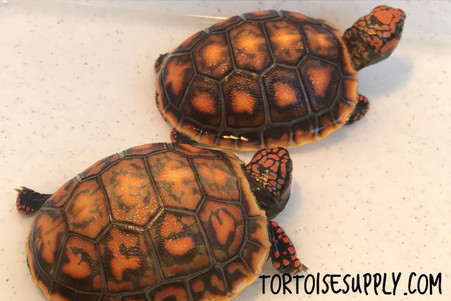- Home
- Tortoises For Sale
- Redfoot Tortoises For Sale
- High Color Baby Redfoot Tortoise
- Home
- Tortoises For Sale
- Baby Tortoises For Sale (All Species)
- High Color Baby Redfoot Tortoise
- Home
- Tortoises For Sale
- Lower Cost Tortoises For Sale
- High Color Baby Redfoot Tortoise
Product Reviews
-
Wonderful baby tortoise & kindest, most professional customer service!

Posted by L. Amanda Barnum on 14th Sep 2017
We received our very 1st baby tortoise a few weeks ago (High color red foot) and could not be happier with our entire experience! I had numerous questions and all were kindly & very timely answered... our tortoise arrived in perfect health, and exactly as described the very next morning... packaged very safe & secure!
Thanks again for everything & most wonderful experience! -
REAL HAPPY

Posted by Karla on 10th Aug 2011
i receive my baby tortoise in the mail around 9am came in a little box, opened it and theirs was the baby red foot, beautiful tortoise real happy with my purchase i recomed this site to anyone its safe and secure!
-
My New Baby High Color Redfoot

Posted by Bob Dienes on 31st Jul 2011
Tyler, my new little baby is PERFECT.
Tyler provides great communication, high quality tortoises and shows the care put into everything.
I bought food too, and know where I'll get all of my products!
I want to explain the name. When I was a young guy, I had a tortoise named "dumb dumb". It was a term of endearment. Now I'm 50 and use the name for my new friend. It reminds me of my childhood and still fits!
Thanks Tyler!!!
Description
These "high color" redfoots represent the most colorful 20% of the redfoots we produce. They have significantly more red and orange on their heads and/or front arms than a typical redfoot. If you are looking for serious redfoot bragging rights, these are your animals!
Common Name: Redfoot Tortoise
Scientific Name: Chelonoidis Carbonaria
Current Size: 2-3"
Average Adult Size: 12-14"
Area of Origin: South and Central America; Few Carribbean Islands
Description: Black shell color, usually with yellow highlights in the centers of each scute of their shell, which are present from hatching (the black color grows in with age). The skin is black, with bright red spots on the front and rear legs. Head color varies between specimens and localities, but is generally black skin with red or yellow scales present mostly on the top of the head. Males generally are a bit more colorful than females. We consider them "watermelon" shaped; somewhat elongated and rounded, no matter which angle you're looking at them from. Males usually have a narrow waistline (hourglass shape) when viewed from above, although this isn't always the case.
Habitat: Naturally these tortoises exist in a wide variety of habitats, from grassland to jungle, almost all with moderate to high humidity and moderate temperatures. They can handle variable amounts of humidity in captivity once grown, but babies should be kept humid to ensure proper smooth growth. They do not hibernate, but will go through a winter slow down period during cooler weather and shortened daylengths. As adults, they can safely handle body temperatures as low as 45 degrees at night as long as they are able to heat up into the 70's during the day. Summer highs up to 100 degrees can be tolerated as long as there is a cooler, shaded retreat the tortoise can get into. Moisture is not a problem in warmer temperatures (a cool mud hole on a hot day), but in cooler weather and on cold nights, the tortoises should be kept dry.
Diet: This tortoise is naturally a browser, and will wander about munching on broadleaf plants and fallen fruit the majority of its natural life. They are known to eat meat in the wild, seen eating dead animals, worms and snails. In captivity, redfoot tortoises will eat almost anything well, such as leafy weeds and clover (dandelions are a favorite), fruit, vegetables and they love Mazuri tortoise diet.
Adult Behavior: Adult redfoot tortoises are interactive and curious tortoises. They are usually unaggressive towards eachother and can usually be kept long term in mixed-sex groups. They are not damaging to their environment, rarely digging holes or burrows. Most redfoots will eagerly come to their keepers looking for food once they are comfortable in their environments.
Our Current Care: These tortoises are currently kept on a moist and deep 2"+ coconut coir substrate with a pile of sphagnum moss on one end for them to burrow into and hide. We mist them heavily once a day about 30 minutes before feeding. Temperatures fluctuate between 65 at night up to 85-90 during the day. Diet consists of spring mix on a daily basis, with moistened Mazuri tortoise diet added a few times a week. We sprinkle the food lightly with a calcium supplement 2 or 3 times a week. The tortoises are removed from their enclosure and soaked in a separate 1/4" deep pan of warm water generally 3 days a week for 30 minutes each time. They do not need intense lighting, but they do need lights on during the day and off at night to maintain a normal day/night cycle. We use full spectrum UVB lights, which we suggest for the growth of pretty, healthy tortoises
 Loading... Please wait...
Loading... Please wait...
